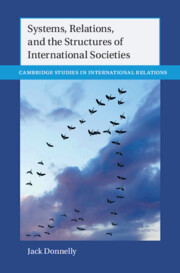Book contents
- Systems, Relations, and the Structures of International Societies
- Cambridge Studies in International Relations
- Systems, Relations, and the Structures of International Societies
- Copyright page
- Contents
- Figures
- Tables
- Acknowledgments
- Part I Systems, Relations, Levels, and Explanations
- Part II Waltzian Structural Theory
- Part III Systems, Relations, and Processes
- Part III (A) Differentiation and Continuous (Trans)Formation
- Part III (B) Four Excursions in Relational/Systemic IR
- 14 Normative-Institutional Differentiation
- 15 Vertical Differentiation
- 16 Levels, Centers, and Peripheries
- 17 Continuous (Trans)formation of Eurocentric Political Systems (c. 1225 – c. 2025)
- 18 Afterword
- References
- Index
- Cambridge Studies in International Relations
16 - Levels, Centers, and Peripheries
Spatio-Political Differentiation
from Part III (B) - Four Excursions in Relational/Systemic IR
Published online by Cambridge University Press: 19 October 2023
- Systems, Relations, and the Structures of International Societies
- Cambridge Studies in International Relations
- Systems, Relations, and the Structures of International Societies
- Copyright page
- Contents
- Figures
- Tables
- Acknowledgments
- Part I Systems, Relations, Levels, and Explanations
- Part II Waltzian Structural Theory
- Part III Systems, Relations, and Processes
- Part III (A) Differentiation and Continuous (Trans)Formation
- Part III (B) Four Excursions in Relational/Systemic IR
- 14 Normative-Institutional Differentiation
- 15 Vertical Differentiation
- 16 Levels, Centers, and Peripheries
- 17 Continuous (Trans)formation of Eurocentric Political Systems (c. 1225 – c. 2025)
- 18 Afterword
- References
- Index
- Cambridge Studies in International Relations
Summary
This chapter develops models of what I call spatio-political structure, rooted in the differentiation of centers and peripheries. Distinguishing between a) the number of top-level political centers, b) the homogeneity or heterogeneity of centers, peripheries, and their relations, and c) the relative autonomy of centers and peripheries, I identify three principal types of political systems (both of which have “international” and “national” forms): systems of single-level governance (e.g., states systems); systems of single-center governance (e.g., empires); systems of multilevel multiactor governance (e.g., medieval Europe). In IR’s standard (Waltzian) structural framing, pre-defined units (individuals and states), on (three) pre-defined levels, combine into pre-defined types of (national and international) political systems. I instead treat as empirical questions the types of polities that exist within a space, their distribution and relations, and the resulting kinds of systems. The chapter concludes with a novel, heterarchic depiction of the turn-of-the-twentieth-century Eurocentric international system.
Keywords
- Type
- Chapter
- Information
- Publisher: Cambridge University PressPrint publication year: 2023

